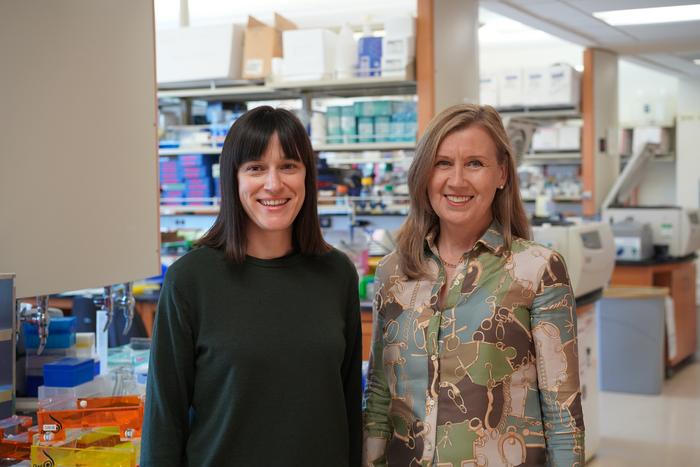UCLA scientists have identified a protein that plays a critical role in regulating human blood stem cell self-renewal by helping them sense and interpret signals from their environment.

Credit: Tiare Dunlap | UCLA Broad Stem Cell Research Center
UCLA scientists have identified a protein that plays a critical role in regulating human blood stem cell self-renewal by helping them sense and interpret signals from their environment.
The study, published in Nature, brings researchers one step closer to developing methods to expand blood stem cells in a lab dish, which could make life-saving transplants of these cells more available and increase the safety of blood stem cell-based treatments, such as gene therapies.
Blood stem cells, also known as hematopoietic stem cells, have the ability to make copies of themselves via a process called self-renewal, and can differentiate to produce all the blood and immune cells found in the body. For decades, transplants of these cells have been used as life-saving treatments for blood cancers such as leukemia and various other blood and immune disorders.
However, blood stem cell transplants have significant limitations. Finding a compatible donor can be difficult, particularly for people of non-European ancestry, and the number of stem cells available for transplant can be too low to safely treat a person’s disease.
These limitations persist because blood stem cells that have been removed from the body and placed in a lab dish quickly lose their ability to self-renew. After decades of research, scientists have come achingly close to solving this problem.
“We’ve figured out how to produce cells that look just like blood stem cells and have all of their hallmarks, but when these cells are used in transplants, many of them still don’t work; there’s something missing,” said Dr. Hanna Mikkola, senior author of the new study and a member of the Eli and Edythe Broad Center of Regenerative Medicine and Stem Cell Research at UCLA.
To pinpoint the missing piece that prevents these blood stem cell-like cells from being fully functional, Julia Aguade Gorgorio, the paper’s first and co-corresponding author, analyzed sequencing data to identify genes that are silenced when blood stem cells are placed in a lab dish. One such gene, MYCT1, which encodes a protein by the same name, stood out as being essential to these cells’ self-renewal capacity.
They found that MYCT1 regulates a process called endocytosis, which plays a key role in how blood stem cells take in the signals from their environment that tell them when to self-renew, when to differentiate and when to be quiet.
“When cells perceive a signal, they have to internalize it and process it; MYCT1 controls how fast and how efficiently blood stem cells perceive these signals,” said Aguade Gorgorio, an assistant project scientist in the Mikkola lab. “Without this protein, the signals from the cells’ environment turn from whispers into screams and the cells become stressed out and dysregulated.”
The researchers compare MYCT1 to the sensors in modern cars that monitor all nearby activity and selectively relay the most crucial information to drivers at the right time, aiding decisions like when to safely turn or change lanes. Without MYCT1, blood stem cells resemble anxious drivers who, used to relying on these sensors, suddenly find themselves lost without their guidance.
Next, the researchers used a viral vector to reintroduce MYCT1 to see if its presence could restore blood stem cell self-renewal in a lab dish. Restoration of MYCT1, they found, not only made the blood stem cells less stressed and enabled them to self-renew in culture but also allowed these expanded cells to function effectively after being transplanted into mouse models.
As a next step, the team will investigate why the silencing of the MYCT1 gene occurs, and then, how to prevent this silencing without the use of a viral vector, which would be safer for use in a clinical setting.
“If we can find a way to maintain MYCT1 expression in blood stem cells in culture and after transplant, it will open the door to maximize all these other remarkable advances in the field,” said Mikkola, who is a professor of molecular, cell and developmental biology in the UCLA College and a member of the UCLA Health Jonsson Comprehensive Cancer Center. “This would not only make blood stem cell transplants more accessible and effective but also improve the safety and affordability of gene therapies that utilize these cells.”
This work was supported by the National Institutes of Health, the Swiss National Science Foundation, the European Molecular Biology Organization, the UCLA Jonsson Cancer Center Foundation, the James B. Pendleton Charitable Trust, the McCarthy Family Foundation, the California Institute for Regenerative Medicine, the UCLA AIDS Institute, the Board of Governors Regenerative Medicine Institute at Cedars-Sinai Medical Center, the Royal Society, the Wellcome Trust and the UCLA Broad Stem Cell Research Center Stem Cell Training Program.
Journal
Nature
Article Title
MYCT1 controls environmental sensing in human haematopoietic stem cells
Article Publication Date
5-Jun-2024



